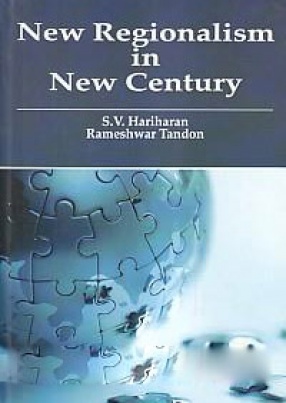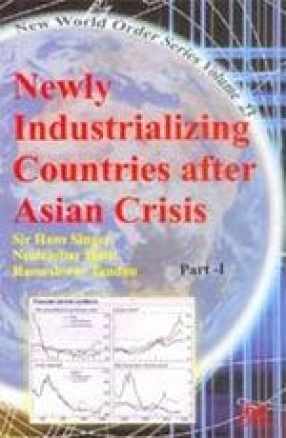
Rameshwar Tandon

Showing all 16 books








Resources are used in the production of various goods. Most of the resources are limited in supply. If the resources are continuously used, it reduces their availability. Hence there is a need to control the uses of resources and the existing resources should be used more efficiently. As a matter of fact, economic growth is constrained by resources. This book discusses the management of common resources, new economics of resources, resources and environmental ...


The severity of global financial criis has highlighted major weaknesses in the international architecture for financial regulation.
Alongside a tendency for globalization of production through foreign direct investment, we have witnessed a parallel tendency towards globalization of foreign capital and a period of revolutionary innovations of foregin the likes of Greenspan to question the coherence of conceptual framework is really unprecedented in systemic ...

Prebisch and Singer found a fall in the prices of developing countries' primary commodities relative to those of British manufactured goods. From their work three branches of literature emerged. First, a statistical debate did arise in regard to the question whether or not developing country's terms of trade are really falling. Second, a series of theoretical models were developed in which terms of trade changes over time could be explained. Third, the policy ...

International trade theory explains the patterns of specialization like cross-country differences in tastes, technology and factor endowments. Traditional trade theory emphasizes comparative advantage as a source of trade. The Ricardian theory predicts that a country will export the products in which it has a comparative advantage. The Ricardian model was very helpful for several issues such as the effects of technological progress on the patterns of ...

If open world trading system continues to be the ultimate goal, then several important questions come up-whether the rise of Regional Trading Arrangements (RTAs) should be welcomed as a step on the road that will ultimately reinforce global free trade or whether regional trading blocks should be condemned as institutions that undermine the multilateral system. Despite GATT requirement that all trade arrangements must submit to a review, no existing arrangement ...

Recent years have witnessed the emergence of several environmental agreements, with trade-restricting provisions, extraneous to the GATT System. Widespread fears have also been expressed that trade liberalization and growth of global trade would cost heavy environmental damage and expanding environmental regulations would create new barriers for trade flows. The current prescriptions for solving these problems are utterly inadequate and do not recognize the basic ...

This volume brings together recent research work relating to the following elements of technology diffusion: 1. Technological competitiveness and DFI. 2. Role of diffusion of technology. 3. Globalization and technological change. 4. Geographical sources of competitiveness. 5. Internationalization of MNCs: case studies--China, Japan and India. 6. Internationalization of Latin American MNCs. 7. Third World MNCs and linkages. This series is dedicated to Raul ...

Transnationalization of economic life is one of the major developments in the late twentieth century. Globalization is centred on the integration of international markets for goods, services, technology, finance and labour. Greater integration has had several effects on the production in national economies, on the role of MNCs and FDI, product differentiation and other aspects of production and consumption. The current scenario can be called global economic ...

In Latin America, sudden collapse of the socialist states was interpreted as a ‘victory of the market economy’ discrediting various forms of social democratic concepts. Moreover, as a result of high growth rates from 1986 onwards and substantial increase in exports, the Chilean model became increasingly attractive as evidence of the viability of new liberal theories. Since early 1990s, the Latin America showed indications of slow recovery from generalised ...

During the last three decades, several countries have moved towards liberalization of their financial systems. This trend towards financial liberalization is part of a broader trend towards reduced direct intervention of the state in the economy. In several LDCs financial liberalization is also a deliberate attempt to move away from "financial repression" as a policy to fund government fiscal imbalances and also subsidized the priority sectors. Moreover ...

The General Agreement of Trade in Services (GATS) is included as Annexe IV to the final text of the Uruguay round agreement. It provides a multilateral framework of principles and rules which should Govern Trade in Services under conditions of transparency and progressive liberalization. It spells out certain general obligations such as extension of MFN principle, maintenance of transparency and a commitment for liberalization in general terms. GATS has been ...

The dominant feature of the world economy in new century is its increasing globalisation and growing fear of its consequences; it also shows marked reversal of attitudes in the third world from the time of Raul Prebisch. In a more independent world economy, any global or regional shock (e.g., the Asian crisis or Russian crisis of 1997-98) is rapidly propagated to other countries. We hear a lot about the creation of a borderless world and the end of nation state. ...

The Uruguay Round of Multilateral Negotiations marked a watershed in the history of the GATT. The final Act embodying the results of Agreement provides a number of agreements creating new international obligations in the area of financial services and extending GATT’s obligations to protection of IPRs, the TRIMs and measures affecting the contestability of service markets. Calls for Post-Uruguay Round negotiation have identified issues such as competition ...

In Africa, more than a decade of economic reforms produced a few cases of renewed growth as also optimism. Of course, all countries in the region, which were, confronted with several constraints e.g. low human capital development, inadequate infrastructure, rapid population growth etc. Growth and development require a predictable regulatory framework and transparent public administration along with an independent judiciary. All these are ...

During the 1990s, the official and private flows showed opposite trends; while the former tended to decline over the years but private capital flows showed significant growth. In view of instability of private capital flows, various emergency packages were designed. But the official development finance and bilateral and consistently lagged behind; at present it is just one third of agreed target of 1 p.c. of GNP of developed countries. Above trend was partly ...
